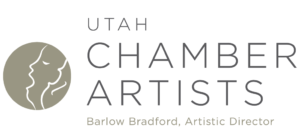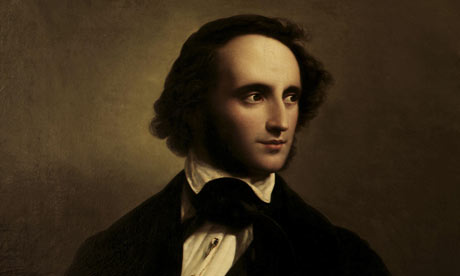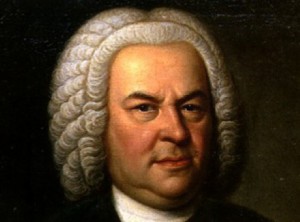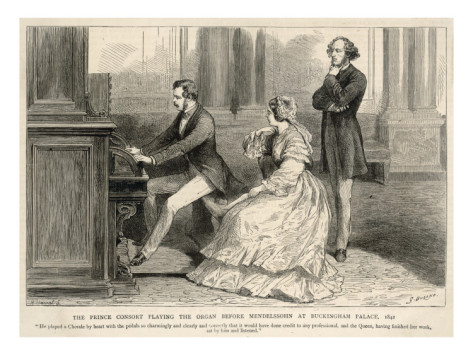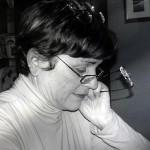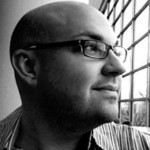Winter Concert Peek
PROGRAM NOTES by Dr. Roger Miller, Professor Emeritus, University of Utah
MENDELSSOHN & …UTAH?
One of the most gifted musicians of all time, Felix Mendelssohn may have a special resonance with Utahns, for several reasons. Born 3 February, 1809 to Jewish parents in the old Hansa city of Hamburg, in what is now Germany, he was of the same generation as many of our own city’s founding fathers. And after an incredibly productive but very brief life of only 38 years, he died on 4 November, 1847, just as the first Utah pioneers were settling in for their first winter in the Valley of the Great Salt Lake. An interesting footnote to this connection is found in an oft-quoted observation of Col. Thomas Kane–friend and champion of the early Utah pioneers. In a discourse delivered to the Historical Society of Pennsylvania in 1850, Kane described one of his several trips to the West, embedded with a company of pioneers, and the effect of the music of Captain William Pitt’s Nauvoo Brass Band, recently arrived intact from England:
It had the strangest effect in the world, to listen to their sweet music winding over the uninhabited country; something in the style of a Moravian death tune blown at day-break, but altogether unique. It might be when you were hunting a ford over the great Platte, the dreariest of all wild rivers, perplexed among the far reaching sand bars and curlew shallows of its shifting bed; –the wind rising would bring you the first faint thought of a melody; and as you listened, borne down upon the gust that swept past you a cloud of the dry shifted sands, you recognized it — perhaps a home-loved theme of Henry Proch or Mendelssohn. Mendelssohn Bartholdy, away there in the Indian marches.
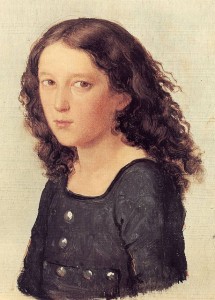 THE BOY & THE MAN – JUDAISM & CHRISTIANITY
THE BOY & THE MAN – JUDAISM & CHRISTIANITY
Mention of the name Bartholdy in connection with Mendelssohn gives rise to another interesting aspect of his story. Rich in wealth and culture, the Mendelssohn family achieved lasting fame with Felix’s grandfather, Moses Mendelssohn, who served as an advisor in the Berlin court of Frederick the Great of Prussia. One of the leading intellectuals of the Enlightenment, Moses was known for the outspoken bluntness of his advice. Challenged by the famous monarch for this directness, Moses, who knew that Frederick enjoyed bowling, is said to have replied, “Even a king needs a pin boy to tell him the score.”
The family’s intellectual brilliance continued in the next generation. Felix’s father, Abraham and his wife Lea, moved to Hamburg, where Abraham became a wealthy banker. The Mendelssohn home continued the tradition of Frederick’s court, becoming a gathering place for the city’s artistic elite, with discussion and music a weekly activity. Every Sunday morning saw a musical salon featuring not only the finest musicians available but often music newly composed by Abraham’s talented son — perhaps a string quartet or similar chamber work. Thus, Felix, from a very early age, not only heard his compositions played by the best musicians available, but benefited from their kindly suggestions and critiques. A boy of his unique gifts progressed rapidly in such an environment, and small wonder that by his early teens he was already composing mature works that would soon lead to incredible masterpieces.
In the troubling atmosphere of 19th-century Europe, the Mendelssohns, like many Jewish families, wanted to avoid the problems caused by the pervasive racial prejudice of the age. This meant converting to Lutheranism, which the children did, in 1816, shortly after Felix’s 7th birthday, followed by the parents’ baptism in 1822, at which time the surname Bartholdy was proposed by Lea’s brother, Jakob Salomon Bartholdy, in place of the obviously Jewish name “Mendelssohn” which Abraham hoped to disavow. Felix adopted a compromise, signing his name Mendelssohn Bartholdy, but with some indication of distaste for the irrelevant name. Baptism placed Felix in a world that tried to balance an ancient Jewish heritage with the values and beliefs of a modern Christian society. Some have questioned whether the conversion was sincere, but to all appearances Felix remained a devout Lutheran for the rest of his life. His two oratorios, Elijah (the Old Testament prophet) and Paulus (on the life of the Christian apostle) symbolize the two aspects of this divided world.
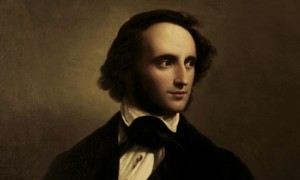 Mendelssohn’s lifespan, wholly encompassed within the first half of the 19th century, overlapped that of Beethoven (d. 1827) by 18 years, long enough for the older composer to have heard several of his finest compositions, including the exquisite Octet and the justly famous Overture to A Midsummer Night’s Dream, both composed well before Mendelssohn’s 18th birthday. His own contemporaries included such musical luminaries as his sometime friend and colleague Robert Schumann (b. 1810), Hector Berlioz (b. 1803), Frederic Chopin (b. 1810), and Richard Wagner (b. 1813). Well aware of the contemporary musical scene, as a conductor and pianist (one of the most gifted), as well as a composer and educator (in the famous Leipzig Conservatory), Mendelssohn was often unsympathetic to the more radical ways of the Romantic age. Certainly Beethoven’s music was appreciated and influential, but perhaps his most profound influences came from J. S. Bach, whose church cantatas are the direct model for the Psalm cantatas in this program, and Mozart, whose elegant but multi-faceted style is reflected in much of Mendelssohn’s music and to whom Mendelssohn’s precocious abilities are often compared. Mendelssohn is thus frequently characterized as a Classical Romantic, but this term, while accounting for his retrospective conservatism, is inadequate to describe his progressive thinking. In fact, some have regarded his influence in the first half of the 19th century as second only to Beethoven’s, and have even extended it well the 20th century, especially with regard to his skillful orchestrations, magical scherzos, and elegantly-conceived music for the piano.
Mendelssohn’s lifespan, wholly encompassed within the first half of the 19th century, overlapped that of Beethoven (d. 1827) by 18 years, long enough for the older composer to have heard several of his finest compositions, including the exquisite Octet and the justly famous Overture to A Midsummer Night’s Dream, both composed well before Mendelssohn’s 18th birthday. His own contemporaries included such musical luminaries as his sometime friend and colleague Robert Schumann (b. 1810), Hector Berlioz (b. 1803), Frederic Chopin (b. 1810), and Richard Wagner (b. 1813). Well aware of the contemporary musical scene, as a conductor and pianist (one of the most gifted), as well as a composer and educator (in the famous Leipzig Conservatory), Mendelssohn was often unsympathetic to the more radical ways of the Romantic age. Certainly Beethoven’s music was appreciated and influential, but perhaps his most profound influences came from J. S. Bach, whose church cantatas are the direct model for the Psalm cantatas in this program, and Mozart, whose elegant but multi-faceted style is reflected in much of Mendelssohn’s music and to whom Mendelssohn’s precocious abilities are often compared. Mendelssohn is thus frequently characterized as a Classical Romantic, but this term, while accounting for his retrospective conservatism, is inadequate to describe his progressive thinking. In fact, some have regarded his influence in the first half of the 19th century as second only to Beethoven’s, and have even extended it well the 20th century, especially with regard to his skillful orchestrations, magical scherzos, and elegantly-conceived music for the piano.
However, despite his precocious beginnings and prodigious accomplishments, there has always been a certain ambiguity about Mendelssohn. His career is often seen as meteoric. He is regarded as a star of great potential that never fully formed, and whose music — especially his choral music — never achieved the ultimate measure of its promise. The problem, according to this view, was not so much that his talent waned or that he peaked too soon, but that his extraordinarily busy life and multiple interests outside of composing left precious little time for developing his inherent skills. Consequently, the musical world — not quite sure what to make of him — periodically mounts efforts to revive his music and resurrect his reputation. The issue is mostly academic, as will be seen as we examine the choral pieces to be performed on this concert.
TWO PSALMS FROM THE “HALLEL”
As we have said, Mendelssohn remained a devout Lutheran throughout his life. However, nothing could make more clear that he did not cease to honor his Jewish heritage than his setting of Psalms 114 and 115 for chorus and orchestra. They represent a type of choral sound that was, along with his two oratorios Paulus and Elijah, the primary model for sacred music and hymnody, especially in England and America, for more than a century after his death. These two psalms, along with four others — Psalms 113, 116, 117, and 118 — are part of the Jewish “Hallel” (“Praise”), a sequence of six Psalms commemorating Israel’s deliverance from Egypt, chanted at important festivals or holy days associated with leaving Egypt, such as Passover, Shavuot (receiving the Torah at Mt. Sinai), and Sukkot (Feast of the Tabernacles) and, recently, other events celebrating divine intervention in the salvation of the Jewish people. According to the Jewish Encyclopedia, “These psalms were evidently written to be sung publicly on some day of thanksgiving, as appears from the verse: ‘This is the day which the Lord hath made; we will rejoice and be glad in it’.” (Ps. 118:24) It is interesting that in the Jewish Encyclopedia, among several mentions of modern settings of the Hallel (including those of his contemporaries Halevy and Meyerbeer), there is no mention of Mendelssohn’s, perhaps for obvious reasons. Nevertheless, Mendelssohn seems to have been fully aware of the Hallel’s musical history, and his settings appear to be responsive to that tradition — an indication that he honored the sacred meaning of the Hallel and was sensitive to its important place in his own personal life, as well as his family history.
Robert Schumann praised Mendelssohn as the most important sacred music composer of his time. Each of his Psalm cantatas (Psalm 115, composed in 1830 and Psalm 114 in 1839), is a large and imposing multi-movement work, written in the spirit of J. S. Bach’s Lutheran church cantatas. In 1829, at the tender age of 20, Mendelssohn had almost single-handedly engineered the so-called “Bach Revival” by conducting a performance of the St. Matthew Passion, Bach’s virtually forgotten masterpiece, which had languished in oblivion for almost half a century. Later, at the invitation of Schumann, Mendelssohn became the conductor of the legendary Gewandhaus Orchestra in Leipzig, the city where Bach had spent the last decades of his life and where he composed the Matthew Passion and many of his most famous cantatas. Most probably, Psalm 114 and the two other Psalms of this period (including the lovely and perhaps better known Psalm 42 “As the Hart panteth after the water brooks”) were meant for the city’s traditional performances of large sacred works during Advent, Lent, and on New Year’s day. They were repeatedly performed in Leipzig on such occasions, as was the earlier Psalm 115, at least once. Small wonder that Bach’s influence can be felt throughout Mendelssohn’s works of this period.
Much of the rich choral sound and dramatic orchestration heard in the Psalm settings draws from a sonic conception already heard in the Paulus oratorio (1836) and later perfected in Elijah, composed just seven years after Psalm 114, in 1846. In fact, the Psalms may be regarded as important stepping-stones leading to this last and most imposing of Mendelssohn’s choral masterpieces, in which skillful contrapuntal passages find a comfortable place side by side with the power and occasional bombast of the Romantic sensibilities of the day. When Mendelssohn’s highly developed narrative skill is added to the mix, it is easy to see that the Psalms deserve a place of distinction not only in the evolution of Mendelssohn’s style but as important and aesthetically pleasing works for our own time.
Psalm 114, “Da Israel aus Äegypten zog” (“When Israel came out of Egypt”), for double chorus and orchestra, in G major, Op. 51 (1839)
1 Allegro con moto maestoso, “When Israel went out of Egypt”
2 Allegro moderato, “The sea saw it and fled”
3 Grave, “What ailed thee, O thou sea?”
4 Con moto, “Tremble, thou earth, at the presence of the Lord”
This is the late Mendelssohn, approaching the oratorical style of Elijah. The structure of Psalm 114 in four movements follows that of the Psalm itself, beginning with an opening chorus setting the scene for several crucial events associated with the flight from Egypt and subsequent return to the land of Israel: the parting of the Red Sea, Moses’ striking the rock from which potable water sprang forth in the desert, the trembling of the earth when God gave the ten commandments to Moses on Mt. Sinai, and the stopping of the waters of the Jordan River, so that the Israelites could cross to the Promised Land. Movement 2’s wiry counterpoint may depict the roiling, angry waters, when the text says, “The sea saw it, and fled: Jordan was driven back.” Movement 3 responds with clever rhetorical pauses, as if expecting an answer to a series of curious questions asking why the elements responded as they did to these supernatural events. Movement 4, a regal finale punctuated with trumpet fanfares, seems to project the quaking of the earth before the presence of God as Israel looks on from the base of the Holy Mountain. A condensed recap of the opening movement leads to a lengthy and grand Alleluia, which serves as a dramatic coda with brass and timpani, befitting the “Hallel’s” overall topic of praise.
Psalm 115, “Nicht uns, Herr” (“Not unto us, O Lord, …but unto thy name give glory”), for soloists, chorus and orchestra, in G minor, Op. 31 (1830)
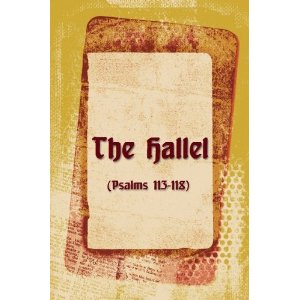 1 Chor, “Not unto us, but to thy name give glory”
1 Chor, “Not unto us, but to thy name give glory”
2 Duett (Soprano and tenor) mit Chor, “O Israel, trust in the Lord,”
“He is mindful of us and will bless us”
3 Arioso (Baritone) “The Lord shall increase thee, more and more”
4 Chor, “The dead praise not the Lord, but we will bless the Lord for evermore”
Psalm 115 was composed in 1830, only a year following the revival of the St. Matthew Passion. The influence of Bach is immediate in the opening sinfonia, incorporating chorus and orchestra in a baroque display of dazzling counterpoint worthy of the great master himself. This is a mark of Mendelssohn’s genius: so clearly has he imitated the style of Bach that one could easily imagine this as the opening chorus from a heretofore unknown cantata or perhaps a newly discovered Passion. But this is not simply Mendelssohn’s longing glance backward to a lost past; it is rather a recognition of what one might learn from perhaps the greatest musician of all time (at least in the Western tradition). Indeed, the music of every composer after Bach takes a giant leap forward after an in-depth encounter with him. Mendelssohn recognized this in the music of Mozart and Beethoven, and was eager to garner it for himself. Thus, we have in this work reflections of a genuine baroque cantata, complete with cantus firmus (albeit cast in Mendelssohn’s own terms). The soprano/tenor duet has strong elements of Romanticism, while modeling a baroque solo/chorus. A lyrical arioso (Mvt 3) for baritone and the final chorus, beginning with a typical chorale (Mvt 4) also reflect Bach through Mendelssohn’s eyes. All in all, refined and luminous choral/orchestral sound that is a joy to hear.
CRASHING WAVES AGAINST VAULTED WALLS
– The Hebrides Overture
The Hebrides Overture, popularly known as “Fingal’s Cave” has retained its broad appeal across time, surely one of the most vivid pieces of nature painting ever composed, and that by a man with the keen eye of a skilled watercolorist, for Mendelssohn, like several other well-known composers and performers, including Arnold Schoenberg and Enrico Caruso, was a talented artist.
One of Mendelssohn’s most successful orchestral works, the Hebrides Overture belongs to a genre known as concert overtures, that is, a single-movement orchestral work modeled loosely along the lines of a traditional theatrical overture but usually following the more structured outline of a conventional sonata form. Because the concert overture is not connected with any extant dramatic work, this concept allows the composer wide latitude in creating descriptive or narrative imagery. It proved to be the perfect vehicle for a work inspired by Mendelssohn’s 1829 visit to Scotland’s Fingal’s Cave, a large basalt sea cave on the island of Staffa in the Inner Hebrides, now part of Scotland’s National Nature Reserve. An important feature of the cave is its naturally arched roof and “eerie” acoustics caused by waves lapping against the cave’s perpendicular lava columns, the unusual geometric shape and grouping of which resembles nothing so much as a gigantic pipe organ.
The effect of such a fantastic natural phenomenon on the fertile imagination of a composer like Mendelssohn was predictable. Its initial inspiration was immediate: a mysterious, cascading theme, compact and bursting with energy, seemed to replicate the peculiar aura of the cave: weird echoes and strangely regular lava columns rising out of the swirling sea water. Out of this brief motif, Mendelssohn conceived a standard sonata exposition, with a calm second theme (heard first in the lower strings, then in the upper strings) followed by a closing segment of brilliant brass fanfares, as if the cave were some sort of medieval fortress by the sea, with echoes of Scotland’s many dramatic struggles for independence.
These thrilling fanfares, stabbing and jousting from every direction, are hardly begun when they begin to disintegrate, as the overture’s form moves seamlessly from exposition to development. Here, Mendelssohn seems to compress the cave’s every sonic nuance into mystery, including a strange little march-like tug-of-war (winds vs. strings) telling of some vivid elemental struggle hidden among the secrets of the cave.
A thrilling climax signals the almost whispered return of the primary theme, but this is not a conventional recapitulation. Almost immediately the listener is caught up in another tremendous embroglio, and instead of fanfares bringing the overture to its close, we find ourselves back inside the cave’s rocky interior, once again thrashing about in the swelling surf. For a few moments the old fanfares and wild echoes of some forgotten battle seem to rebound like crashing waves against the vaulted walls, but, imperceptibly, the frenzied energy dissipates and everything begins to reintegrate, both musically and dramatically, as each of the elements return to its proper place. This time the expected closing chords, interspersed with the final echoes of the opening theme, bring the work to a not quite settled conclusion, as if the curtain were about to rise on the real story behind the cave’s untold history.
